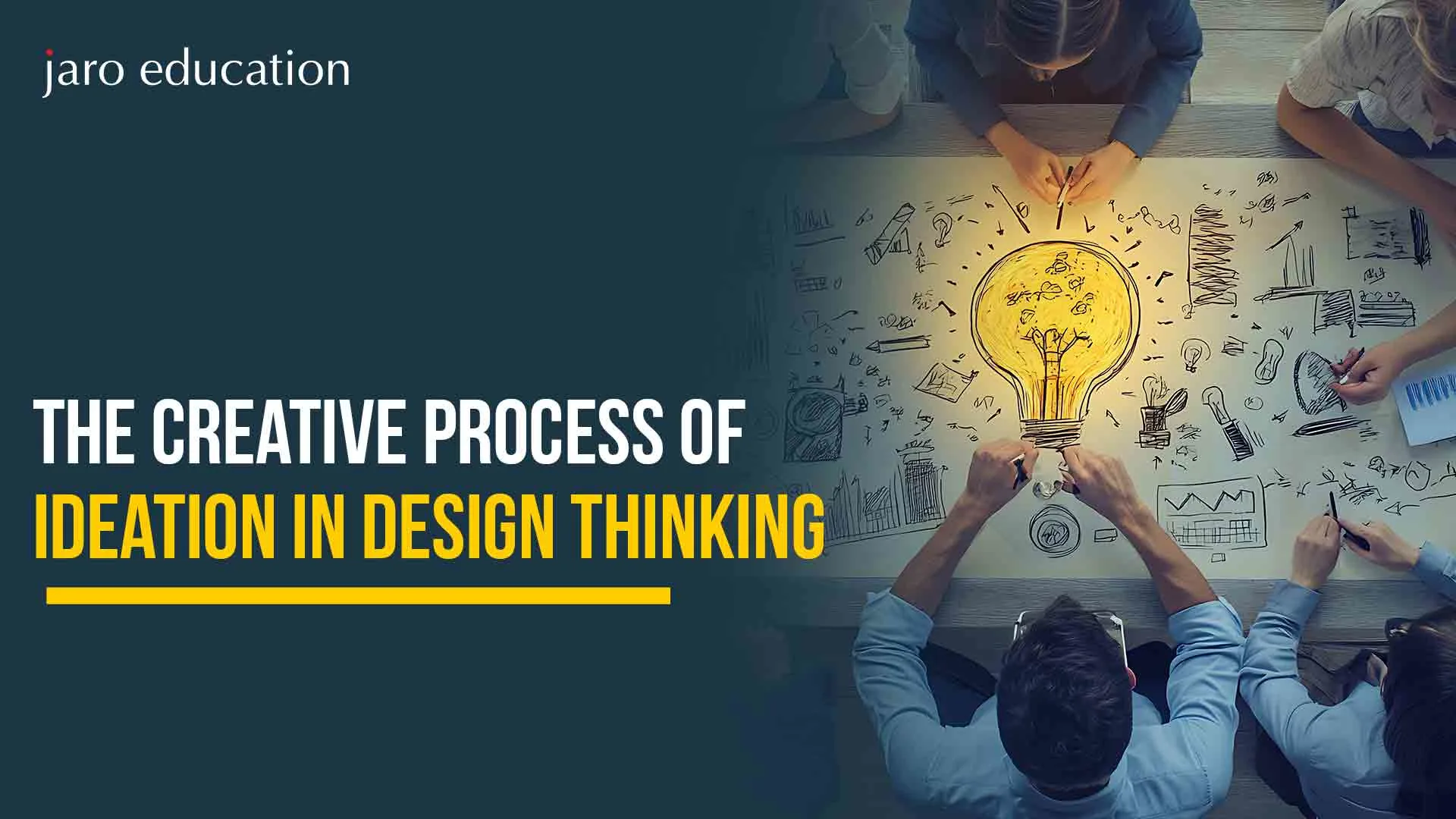The Creative Process of Ideation in Design Thinking
Table of Contents

By now, you must have heard about the design thinking process. If not, let’s talk about it now.
Nowadays, industries are more involved in a human-centric approach to bring their brand to the market and create effective ideas that serve customers better. This involves understanding market trends, consumer behaviours, and interests, followed by brainstorming potential solutions. But how does ideation fit into the design thinking framework, and what benefits does it offer beyond mere idea generation?
Think of ideation as a dazzling fireworks display. Imagine shooting a single flare into the night sky only to experience a cascade of colours, lights, and patterns. Exciting, isn’t it? This is what ideation is—a blank canvas transformed into a vibrant array of possible solutions through techniques like sketching, prototyping, brainstorming, brainwriting, and even the “Worst Possible Idea”.
This ideation stage of design thinking helps your team come up with a large number of ideas that spark innovative solutions. Thus, deeply understanding how to collaborate on these ideas will let your team think outside the box and impress users.
So, in this blog, let’s learn how to get the most out of your ideation design thinking.
What’s the Ideation Stage of Design Thinking?
Ideation in designing the thinking process is often referred to as the brainstorming bonanza. If you’re thinking it’s the first step of any design thinking process, let us tell you that ideation is the third step after empathise and define.
In ideation design thinking, it’s all about ideas! This is the “quantity over quality” stage—don’t worry about whether you have the right solution; just let your imagination run wild. Imagine a product team collaboratively trying to address the challenge of converting free users of their app into subscribers.
They would be in a brainstorming session working as a team. You would see team members in small groups or pairs, each identifying ideas, freely bouncing them off each other, and building off of each other’s ideas. The point is to create ideas that lead to creative solutions! By the end of this, they would have an abundance of ideas they could analyse and distill for the next steps of prototyping and testing. So, put your thinking caps on and start thinking creatively; this is the exciting part!
Why the Ideation Stage of Design Thinking is So Important

*careerfoundry.com
The ideation phase of design thinking ignites creativity and innovation for a project. It is a time when teams who have spent time gathering insight around their problems can move into a brainstorming mode of multiple solutions that shows the importance of this phase, in that ideas generated in this phase are what will lead you to success in the design thinking process. It allows teams to think differently and come up with truly revolutionary solutions.
Building on Understanding
When you reach the ideation design thinking stage, your team has already performed an empathise and define process. You have a great amount of knowledge of your customers’ needs and pain points. You have heard their stories and experienced their stories. You have developed a deep empathy for the user experience, and this is what makes ideation so powerful.
You are not just throwing random ideas or tossing things at the wall to see if they stick; you are creating solutions that actually address legitimate problems. With an understanding of the user experience, the team can interrogate assumptions and reframe problems. This is where the fun starts! You get to turn users’ pain points or struggles into tangible ideas that can lead to real solutions.
A Foundation for Future Stages
The ideation design thinking phase doesn’t just stand alone; it paves the way for the next crucial steps in the design thinking process: prototyping and testing. The ideas generated during ideation will serve as the blueprint for what you’ll build and test later on. However, design thinking isn’t a straight line. It’s a dynamic process that allows teams to revisit earlier stages if needed, tightening up ideas and refining them to better meet user needs.
The Major Benefits of Ideation
Participating in the ideation stage offers numerous benefits for teams. Here’s a closer look at what makes this phase so valuable:
1. Diverse Perspectives
One of the most exciting things about ideation is the different perspectives of each team member. All different experiences and perspectives will contribute to the exploration of ideas, making it a richer and deeper exploration of possible solutions. It’s not uncommon for unanticipated breakthroughs to come from this diversity. People from different backgrounds or perspectives will typically contribute new ideas, which may not come if a group of ten had similar perspectives.
2. Enhanced Collaboration
Ideation creates a collaborative environment where hierarchy is no longer required. The atmosphere encourages everyone to contribute ideas, fostering unity and teamwork, which benefits the ideas created as well as their relationships as team members. Working together makes everyone feel part of what happens with the project going forward.
3. A Cloud of Ideas
One of the goals of the ideation design thinking phase is to generate a vast array of ideas—think of it as creating a big cloud of possibilities. By encouraging participants to brainstorm freely, you can help eliminate the fear of judgment that often stifles creativity. In this open environment, unconventional ideas can flourish, leading to innovative solutions that might otherwise remain hidden.
4. Boosted Innovation Potential
When teams ideate, they create the conditions for innovation. In this phase, team members can think disruptively and outside conventional boundaries to develop disruptive solutions to meet the emerging needs of users and customers. In a creative setting, teams can accomplish the design of products and services that allow for true human experiences.

*chisellabs.com
Overcoming Challenges in Ideation
Although ideation design thinking is often one of the more energising phases, there are some challenges that one may have to face. For example, you may find your group suffering from groupthink, where everyone comes together to the dominant ideas, or individuals struggle to voice their ideas.
However, you can easily mitigate both groupthink and ideas that go unvoiced by seeding a collaborative environment that welcomes everyone’s voice. Using brainstorming, mind mapping, or even role-play is a way to stimulate and tap into everyone’s creativity and to ensure you are capturing all ideas. In the end, you want to create an environment where your colleagues feel free enough to share the most radical ideas they have without fear of being chastised.
How to Run the Ideation Phase of Design Thinking: A Step-by-Step Guide
If you’ve had a successful ideation phase during a design thinking process, it can feel like you tapped into a gushing fountain of creativity. It is the moment that your team can brainstorm together and come up with creative ideas to solve the issues you have identified. Now that you’re ready to start ideating, here’s how to maximise your time during this exciting phase!
Step 1: Define the Problem
Before you begin brainstorming, it’s important to define the challenge. Consider the problems you found during the empathise phase. Which challenges have you chosen to focus on? This is where you can be precise about the exact challenge that your team will work to solve. Start the problem definition process with a “How might we” statement. For example, if your challenge is improving user experience in an app, you might ask, “How might we create an easy-to-use user experience?” Which states the challenge and gets everybody to think positively that solutions exist.
Step 2: Choose a Space
The environment you choose for your ideation session can significantly impact creativity. Opt for a spacious room equipped with whiteboards or ample wall space where you can jot down ideas freely.
Consider selecting a location away from your usual workspace. A fresh environment can spark new perspectives and ideas. To help participants feel more relaxed and engaged, kick things off with some fun icebreaker activities. This sets a positive tone for the session!
Step 3: Set Time Limits
Setting time limits is essential for maintaining energy and momentum in your ideation session. Decide beforehand how long you plan to brainstorm for each problem. This could be for 30 minutes or an hour, depending on how complex the challenge is. Also, set a target for how many ideas you would like to generate. The pressure of having to think up ideas quickly can help create an urgency that leads to a rush of creativity. Remember, you want to get the ideas flowing!
Step 4: Select Ideation Techniques
Now comes the fun part—choosing your ideation techniques! There are several methods you can use to inspire creativity:
- Brainstorming: Gather everyone in a circle and verbally share ideas. Encourage spontaneity and build off one another’s thoughts.
- Mind Mapping: Start with a central keyword related to your problem and branch out with associated ideas. This visual approach can reveal connections you hadn’t considered.
- Storyboarding: Create visual narratives that illustrate how users could interact with your solutions. This method helps to visualise the user experience.
- Worst Possible Idea: Sometimes, thinking of the worst ideas can break down mental barriers. It’s a fun way to challenge assumptions and spark new thoughts.
Step 5: Rank the Ideas
After a valuable session, you probably have a lot of ideas. It’s time to sort them out! As a group, sort the ideas into one of the categories you created, such as promising, interesting, original, or crazy. Prioritising the ideas will help you remember what sounded the most interesting to the group. Be sure not to throw your ideas away completely; even the crazy ones might be useful for other projects! Make sure you have everything written down!
Step 6: Choose Ideas for Prototyping
The ultimate aim of the ideation design thinking phase is to identify ideas that can be developed into prototypes. Review the ranked ideas and select those that have the most potential. Make sure to keep a record of the ideas that didn’t cut. They could be useful down the line or inspire a different project.
Explore the Design Thinking Course
So, are you interested in learning design thinking? If you are, then consider the Executive Programme in Product Innovation & Design Thinking for Business Growth offered by CEP, IIT Delhi. The programme equips professionals with the skills and knowledge needed to develop and manage innovative products that fuel business growth. It emphasises the application of design thinking and management principles. You’ll engage in lectures, hands-on activities, and case studies while connecting with a diverse group of peers. Additionally, you’ll receive mentorship from experienced professors at IIT Delhi, founders, and industry experts.
Register for Online Courses With Jaro Education
Jaro Education is your go-to destination for online higher education and upskilling, backed by years of experience and expertise. Our mission? To provide passionate learners like you with top-notch career counselling and academic guidance.
At Jaro Education, we team up with India’s leading institutions to bring you the best online courses in management, marketing, and technology. Our programmes are tailored to equip you with the essential skills and knowledge needed to thrive in today’s competitive business world.
Plus, we partner with prestigious institutions like IITs and IIMs in marketing and technology to ensure you receive cutting-edge education that’s both relevant and impactful. Join us and take the first step toward your future success!
The Final Thoughts
The ideation design thinking phase is a crucial part of the creative process. It takes your understanding and turns that into something actionable, where teams can brainstorm and come up with lots of different possibilities. Teams can find new and innovative solutions by tapping into different perspectives, fostering collaboration, and allowing ideas to flow freely related to the problems they are dealing with.
As you start to ideate, embrace the non-linear aspect of design thinking. Use every round of brainstorming to get rid of ideas and keep your eyes (and the users’ eyes) on the solutions you were brainstorming at the beginning. In this way, you will extend your team’s creativity and work toward finding solutions that are relevant to your users! So, bring your team together, let ideas flow, and get ready to dive into a great discovery!
Frequently Asked Questions
What is the Concept of Ideation?
Ideation is all about coming up with new ideas. It’s a creative process where you generate, develop, and share thoughts that can be visual (like drawings), concrete (like physical products), or abstract (like concepts). The ideation process consists of four main steps: finding the problem, gathering facts, defining the problem, and finally, brainstorming ideas.
What is the Role of Ideation?
The role of ideation is to systematically create and refine valuable ideas. It’s a structured method that involves several phases. As you move through the process, you might start with a lot of ideas, but you’ll narrow them down to focus on the best and most in-depth options.
What is the Skill of Ideation?
Ideation skills involve generating, developing, and evaluating ideas for specific goals, like solving a problem, designing a product, or improving a process. These skills are vital for fostering creativity and innovation, especially when working in a team setting.
What is Prototype Ideation?
Prototype ideation is the phase where the goal is to come up with creative solutions to meet users’ needs and challenges. During this stage, the design team’s creativity and imagination should be at their peak, allowing for innovative ideas that can lead to effective prototypes.
















